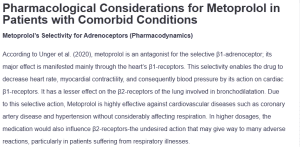Pharmacological Considerations for Metoprolol in Patients with Comorbid Conditions
Metoprolol’s Selectivity for Adrenoceptors (Pharmacodynamics)
According to Unger et al. (2020), metoprolol is an antagonist for the selective β1-adrenoceptor; its major effect is manifested mainly through the heart’s β1-receptors. This selectivity enables the drug to decrease heart rate, myocardial contractility, and consequently blood pressure by its action on cardiac β1-receptors. It has a lesser effect on the β2-receptors of the lung involved in bronchodilatation. Due to this selective action, Metoprolol is highly effective against cardiovascular diseases such as coronary artery disease and hypertension without considerably affecting respiration. In higher dosages, the medication would also influence β2-receptors-the undesired action that may give way to many adverse reactions, particularly in patients suffering from respiratory illnesses.
Effects on the Cardiovascular System (Pharmacodynamics)
By effectively selective β1 blockade, Metoprolol profoundly impacts the cardiovascular system by reducing myocardial oxygen demand. Metoprolol decreases the heart rate and the force of myocardial contractions, hence decreasing the heart’s workload, especially in patients with coronary artery disease (Sayers et al., 2021). Concurrently, it plays a role in the reduction of blood pressure through systemic vascular resistance, hence making its antihypertensive effects occur. These effects make Metoprolol a cornerstone for the treatment of patients with hypertension, coronary artery disease, and heart failure.
Metabolism of Metoprolol (Pharmacokinetics)
Metoprolol is highly metabolized in the liver via the CYP2D6 enzyme. Because of genetic variability, there is a large variability among people regarding the activity of CYP2D6, which affects drug metabolism, efficacy, and the side effects associated with this drug (Farzam & Jan, 2023). Poor metabolizers of the enzyme CYP2D6 may result in higher plasma concentrations of Metoprolol, leading to an increased adverse effect profile.
Caution with Beta Blockers in Asthma Patients
Though Metoprolol is selective for β1-receptors, it can still affect β2-receptors in higher doses or when selectivity is compromised, leading to bronchoconstriction. This is particularly concerning in patients with asthma, as β2-receptors in the lungs are responsible for bronchodilation. Blocking these receptors can exacerbate asthma symptoms, which is why healthcare providers must exercise caution when prescribing beta-blockers like Metoprolol to asthmatic patients (Morris & Dunham, 2024).
References
Farzam, K., & Jan, A. (2023, August 22). Beta Blockers. National Library of Medicine; StatPearls Publishing. https://www.ncbi.nlm.nih.gov/books/NBK532906/
Morris, J., & Dunham, A. (2024, February 29). Metoprolol. Nih; StatPearls Publishing. https://www.ncbi.nlm.nih.gov/books/NBK532923/
Sayers, E. W., Bolton, E. E., Brister, J. R., Canese, K., Chan, J., Comeau, D., Connor, R., Funk, K., Kelly, C., Kim, S., Madej, T., Marchler-Bauer, A., Lanczycki, C., Lathrop, S., Lu, Z., Thibaud-Nissen, F., Murphy, T., Phan, L., Skripchenko, Y., & Tse, T. (2021). Database resources of the National Center for Biotechnology Information. Nucleic Acids Research, 50(D1). https://doi.org/10.1093/nar/gkab1112
Unger, T., Borghi, C., Charchar, F., Khan, N. A., Poulter, N. R., Prabhakaran, D., Ramirez, A., Schlaich, M., Stergiou, G. S., Tomaszewski, M., Wainford, R. D., Williams, B., & Schutte, A. E. (2020). 2020 international society of hypertension global hypertension practice guidelines. Hypertension, 75(6), 1334–1357. https://doi.org/10.1161/hypertensionaha.120.15026
ORDER A PLAGIARISM-FREE PAPER HERE
We’ll write everything from scratch
Question 
You have a 58 year old African American male that is coming in for a follow-up visit after recently having a Myocardial infarction which was successfully treated via angioplasty. He was started on Metoprolol for his consistently elevated high blood pressure during his hospital stay.
His primary diagnoses include:
- Coronary Artery Disease
- Type 2 diabetes controlled with Metformin 1,000 mg BID and HgA1C of 6.7.
- Asthma- Mild Intermittent- with no recent episodes of wheezing. Albuterol INH as needed.
- All other pertinent labs Within Normal Limits
First consider what clinical guidelines noted below can help us choose the best medication treatment for this patient with diabetes, CAD, Asthma and Hypertension.
Joint National Committee JNC 8 – https://thepafp.org/website/wp-content/uploads/2017/05/2014-JNC-8-Hypertension.pdf
National Center for Biotechnology Information – https://www.ncbi.nlm.nih.gov/pmc/articles/PMC6092891/table/T1/?report=objectonly
American Heart Association – https://www.ahajournals.org/doi/epub/10.1161/HYPERTENSIONAHA.120.15026
IHS Division of Diabetes https://www.ihs.gov/sites/diabetes/themes/responsive2017/display_objects/documents/algorithms/AlgorithmHypertension.pdf
Please answer each questions citing your response from evidence based clinical guidelines. Your response should not be post as “I would recommend”. Example of appropriate reference: The 2020 international Society of Hypertension Global Hypertension Practice Guidelines – recommend the use of selective ß1-receptor agonists in patients diagnosed with coronary heart disease and or heart failure ( Unger, T, et al, 2020).

Pharmacological Considerations for Metoprolol in Patients with Comorbid Conditions
Reference:
Unger T;Borghi C;Charchar F;Khan NA;Poulter NR;Prabhakaran D;Ramirez A;Schlaich M;Stergiou GS;Tomaszewski M;Wainford RD;Williams B;Schutte AE; (n.d.). 2020 International Society of Hypertension Global Hypertension Practice Guidelines. Hypertension (Dallas, Tex. : 1979). Retrieved August 1, 2022, from https://pubmed.ncbi.nlm.nih.gov/32370572/
- Metoprolol is selective for which adrenoceptor? ( pharmacodynamics)
- What effects do agents such as metoprolol have on the cardiovascular system? ( pharmacodynamics)
- In which organ is metoprolol primarily metabolized? (Pharmacokinetics)
- Why would a provider be cautious when ordering a Beta Blocker in a patient with Asthma?